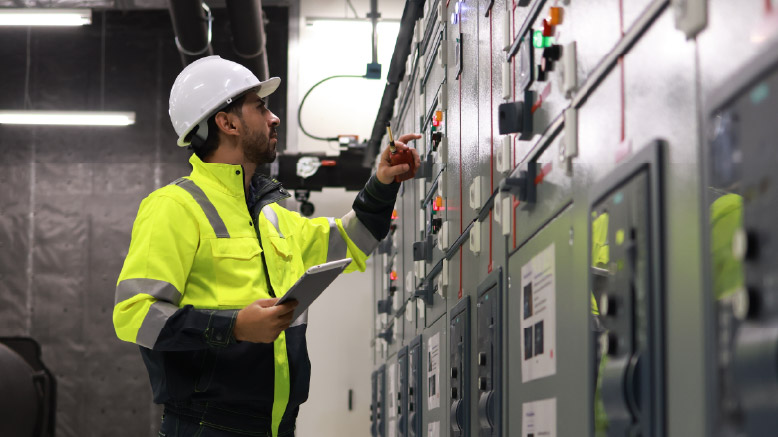— 5 min read
Low-voltage Systems: A New Frontier for MEP Contractors


Last Updated Sep 23, 2025

Brian Taylor
Associate Principal/Director of Low Voltage
Brian Taylor is an Associate Principal and Director of Low Voltage at Jordan & Skala Engineers, with over 14 years in the consulting-engineering industry. Drawn to the ever-evolving world of technology, he found his niche in low voltage consulting, where his passion for innovation meets his appreciation for architecture. Brian leads the Low Voltage team, providing oversight, mentorship, and technical guidance on the design and specification of communications, security, and AV systems. He is deeply involved in every phase of a project, from early design through construction, while also mentoring staff, maintaining standards, and building client relationships.

Diane McCormick
Writer
49 articles
Diane McCormick is a freelance journalist covering construction, packaging, manufacturing, natural gas distribution, and waste oil recycling. A proud resident of Harrisburg, PA, Diane is well-versed in several types of digital and print media. Recognized as one of the premier voices in her region, she was recognized as the Keystone Media Freelance Journalist of the Year in 2022 and again in 2023.
Last Updated Sep 23, 2025

From design through commissioning, low-voltage system designers and the MEP trades are colleagues. They work together to provide the systems that make buildings safe, connected, comfortable, efficient and equipped for modern living.
But low-voltage systems are changing fast. As MEP contractors integrate with low-voltage systems on projects where occupant safety and digital access are key, they can continue to mitigate risk and drive their own operational efficiencies by keeping pace with innovations in low-voltage systems.
This article answers seven key questions about how low-voltage systems are changing and why it matters to MEP.
Table of contents
1. What are low-voltage systems?
The term “low voltage” covers many categories, but it generally refers to the communications, security and audio-visual functions of a future building that can run safely with via Ethernet/IP cabling and low-voltage power.
This can include everything from a conference-room scheduling tablet to digital stadium signage. Within the low-voltage field are the essentials of every commercial and residential project, such as data networks, Wi-Fi, security cameras, access controls and life safety systems.
2. Is low voltage all electrical?
Here, big changes are underway. In the past, when voice and data networks were much simpler, low voltage was exclusively the terrain of electrical engineers. Some of the work still falls under and overlaps with the traditional definition of power delivery under 1,000 volts for a range of functions, which may be covered by electrical engineers, while more communications and IP-specific scope is covered by separate, specialty low voltage consultants.
However, other devices that fall under the low-voltage umbrella, such as cameras and wireless access points, can run on advanced, Cat 6 data cables utilizing the dual power-data delivery method known as Power-over-Ethernet.
PoE technology simplifies cabling by delivering both power and data over a single cable, creating more efficient and less bulky power infrastructure. Low voltage creates the data connections and wireless signals needed to keep HVAC and lighting systems functioning properly and responsive to human and automated commands.
3. When do low-voltage consultants come to the planning table?
The sooner, the better. Most of the industry recognizes this need today.
Historically, low voltage teams would come in with their cabling and devices just before and after the walls were up and systems were installed. However, today’s data-driven, networked buildings require coordination from the start, making low-voltage designers a central part of the planning phase.
Historically, in the construction industry, low voltage wasn't considered something you needed to have up front, but as the systems have evolved, things have become more complex. We're now tied into MEP and other systems because they have data-driven, network-required devices.

Brian Taylor
Associate Principal/Director of Low Voltage
Jordan & Skala Engineers
4. How does MEP intersect with low-voltage systems?
The heart of low-voltage systems is the telecom room or rooms. These rooms house sensitive control and distribution systems that must keep up with the data and system demands of a dynamic building.
On the HVAC side, these control rooms can heat up quickly and intensely, just like data centers. Specialized cooling is essential to prevent equipment from overheating, which can cause malfunctions, disrupt building operations and void warranties.
On the electrical side, low-voltage systems need dedicated daily power, as well as hookups to emergency power. The rooms themselves need many outlets for future equipment, including pieces from telecom providers, that will serve the building’s digital functions for years to come.
5. Do low-voltage systems participate in clash detection?
The short answer is no, at least not for communications cabling. Low voltage has almost zero impact on clash detection. Communications cabling doesn’t transmit enough electricity to constitute a fire risk, with fiber optics even transmitting light in lieu of electricity, and it can run freely through ceiling spaces.
That said, the involvement of low voltage in planning is important for properly placing the outside conduit to the main distribution frame (MDF). Once that conduit is installed with the main slab, it's an easy matter to run additional connections to the intermediate distribution frames (IDF) that the MDF will serve throughout the building.
Strategically installing larger conduits also helps with futureproofing. Fiber optic cabling is much slimmer than the cable it displaces, but extra conduit capacity can prevent costly renovations by preparing for eventualities like multiple telecom providers serving a single building.
6. How do low-voltage systems address a project’s future needs?
Anticipating future needs through extra conduits is common in construction, but low-voltage systems must avoid overdesigning that inflates costs.
As always, it's about using the right equipment for the right spot. Owners might think they need security cameras at every corner, but low-voltage system designers can map out general coverage with multi-lens cameras.
For the owner, rightsizing keeps costs under control, while the contractor mitigates risk with fewer rough-ins and less labor. The widespread use of Wi-Fi is making hardline data outlets rare, and growing demand for bandwidth creates a need for more wireless access points (WAP) to accommodate the many devices in constant use in every building.
7. How will low-voltage systems continue to evolve?
Low-voltage systems provide reliable, energy-efficient solutions in automation, security and communications that today’s owners demand.
As low-voltage design and equipment evolve, MEP contractors will continue to find new opportunities for collaboration and innovation to deliver projects that exceed the expectations of 21st-century owners and occupants.
Free AI in Construction Course with Hugh Seaton
Start learning today with industry expert Hugh Seaton and discover how AI can boost efficiency, reduce risk, and transform your projects.

Low Voltage, High Communication
Modern low-voltage systems are becoming more complex and integrated with other building functions.
MEP contractors can be proactive by advocating for low-voltage system designers to be brought into the planning phase of projects as early as possible. This allows for better coordination and helps mitigate risks associated with design conflicts or improper infrastructure.
By collaborating with low-voltage specialists, MEP teams can plan for key infrastructure like telecom rooms, anticipate future needs and mitigate risk by using the right technology for the job.
Was this article helpful?
Thank you for your submission.
0%
0%
You voted that this article was . Was this a mistake? If so, change your vote
Scroll less, learn more about construction.
Subscribe to The Blueprint, Procore’s construction newsletter, to get content from industry experts delivered straight to your inbox.
By clicking this button, you agree to our Privacy Notice and Terms of Service.
Thank you!
You’re signed up to receive The Blueprint newsletter from Procore. You can unsubscribe at any time.
Categories:
Written by

Brian Taylor
Associate Principal/Director of Low Voltage | Jordan & Skala Engineers
Brian Taylor is an Associate Principal and Director of Low Voltage at Jordan & Skala Engineers, with over 14 years in the consulting-engineering industry. Drawn to the ever-evolving world of technology, he found his niche in low voltage consulting, where his passion for innovation meets his appreciation for architecture. Brian leads the Low Voltage team, providing oversight, mentorship, and technical guidance on the design and specification of communications, security, and AV systems. He is deeply involved in every phase of a project, from early design through construction, while also mentoring staff, maintaining standards, and building client relationships.
View profile
Diane McCormick
Writer | Procore Technologies
49 articles
Diane McCormick is a freelance journalist covering construction, packaging, manufacturing, natural gas distribution, and waste oil recycling. A proud resident of Harrisburg, PA, Diane is well-versed in several types of digital and print media. Recognized as one of the premier voices in her region, she was recognized as the Keystone Media Freelance Journalist of the Year in 2022 and again in 2023.
View profileExplore more helpful resources

Comfort Mood: Making MEP Central to Occupant Comfort
In many post-COVID-19 projects, occupant comfort has transitioned from a “nice to have” to a “must have.” It’s infused into collaborations from the earliest phases of design and preconstruction. That...

The MEP Lifecycle: How Contractors Can Benefit from Thinking Ahead
From the beginning of a project, MEP contractors should be thinking about the lifecycle of their systems. Prioritizing the lifecycle early in the process helps MEP trades influence design, select...

Retrofitting Aging Infrastructure: 5 Essentials for Managing MEP Risk
MEP contractors help preserve aging infrastructure by bringing systems to contemporary standards in sustainability, comfort and accessibility. Although the opportunities are unique, retrofits of existing buildings present known obstacles and...

The Top 5 MEP Challenges of Data Centers
Data centers are unique builds that come with unique challenges. MEP contractors stepping up to build data centers are sure to encounter the complexity of systems and the demands of scalability,...
Free Tools
Calculators
Use our calculators to estimate the cost of construction materials for your next project.
Templates
Find a template to help you with your construction project tasks.
Material Price Tracker
Get the latest U.S. retail prices and view historical trends for common building materials.
Glossary
Explore key terms and phrases used in the industry.
